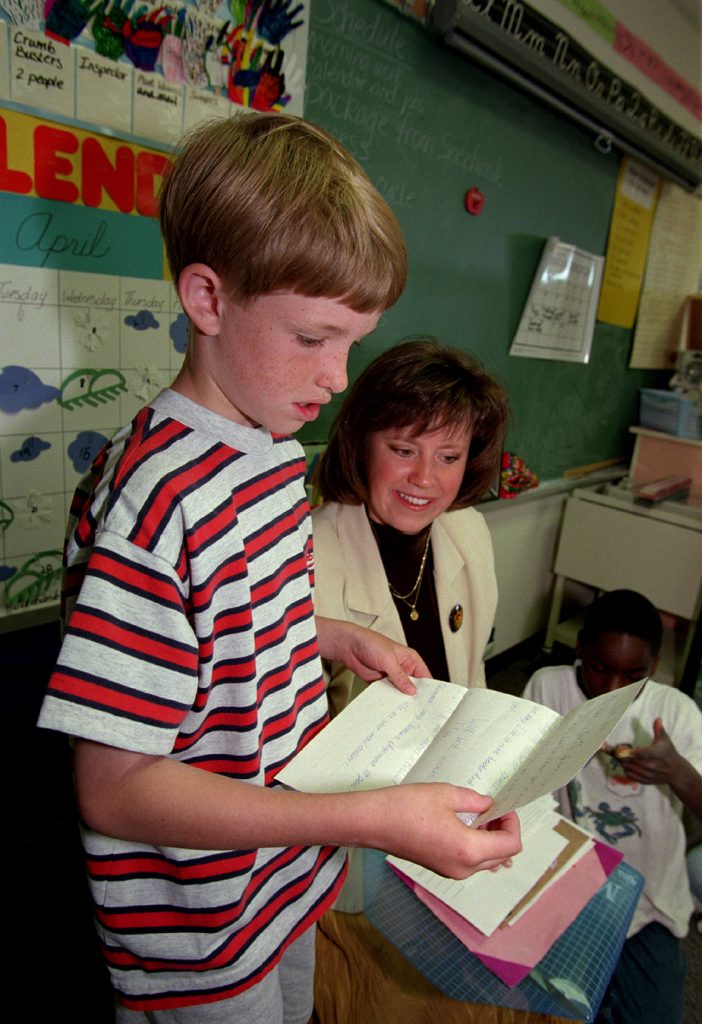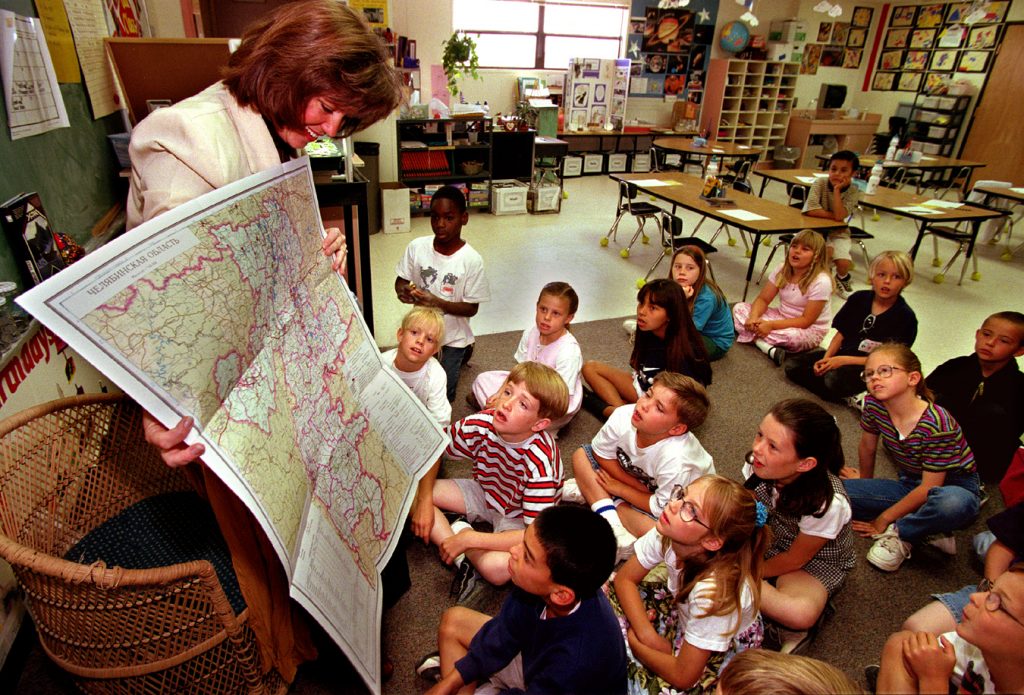
(Photo by Randy Montoya)
Download 150dpi JPEG image, ‘penpals2.jpg’, 1.MB
ALBUQUERQUE, N.M. — Their parents spent their school-age years learning to mistrust Russians. But for the 19 second graders in Janet Sanchez’s Petroglyph Elementary classroom, Russians aren’t reason to “duck and cover.” They’re pen pals, friends, summer camp companions, perhaps. They’re a good reason to check your classroom’s e-mail.
This school year 12 New Mexico teachers and their students are exchanging e-mails, goodwill packages, and the occasional video conference greeting with school children in Snezhinsk, Russia. Located in the southern Urals 800 miles southeast of Moscow, Snezhinsk is formerly one of the Soviet Union’s secret “closed” cities, home of the nuclear weapons design lab known as Chelyabinsk-70.
Sandia National Laboratories, a multiprogram U.S. Department of Energy (DOE) research and development lab based in Albuquerque, is coordinating the program, largely through the volunteer efforts of employees who travel regularly to and from Snezhinsk to work with Chelyabinsk scientists. They often carry packages of small gifts ranging from scrapbooks and video tapes to candy.
The New Mexico participants include kindergarten-aged students at The Learning Circle; elementary school students at Zuni, Georgia O’Keeffe, Petroglyph, and Valencia; middle school students at Desert Ridge; and high school students at Sandia High and the Career Enrichment Center.
“How can we go back to wanting to shoot at each other when our kids are getting to know each other like this?” asks Sandia Labs’ Patricia Newman, who coordinates the School-to-School Program.
The Russians are particularly eager to get to know their American counterparts because former Soviet policies prohibited foreign interactions by residents of its secret cities. “It’s an elite, closed culture,” she says. “These kids wouldn’t have had these opportunities during the Cold War.”

(Photo by Randy Montoya)
Download 150dpi JPEG image, ‘penpals1.jpg’, 1.3MB
Technologies make the world smaller
Sanchez’s students correspond every few weeks with students in Nina Morozova’s and Anastasia Maslova’s classes at Snezhinsk School 121, exchanging e-mail greetings and sending by special courier drawings and stories depicting their classrooms, classmates, homes, and families.
A few of the participating classes are taking advantage of video conferencing equipment available at Sandia’s Cooperative Monitoring Center and at Chelyabinsk-70 that have allowed some very personal exchanges, via satellite, between classrooms more than 9,000 miles apart. The three video conferences so far have been marked by amiable, sometimes lively exchanges, Newman says. In one session, Russian children sang Russian songs and taught their American counterparts to sing along. In another, teachers got to know each other exchanging jokes and intercontinental shop talk.
The students converse in English, as many schools in Snezhinsk begin teaching English language skills at very early ages.
“The world is becoming smaller and smaller, and it’s important we talk to each other,” Sanchez says. “These are relationships the kids can take with them throughout their lifetimes.”
The telecommunications equipment being used to conduct the video conferences was installed at Chelyabinsk-70 last year as part of DOE’s Initiatives for Proliferation Prevention (IPP), an ongoing program under which researchers at DOE labs work with former Russian weapons scientists to develop nonmilitary technologies with possible commercial value. IPP’s goals include providing meaningful work for highly skilled Russian scientists, removing the temptation for some Russian scientists to seek weapons-related work outside Russia, and spurring Russian and U.S. economic development. In one IPP-sponsored project, Russian scientists are working with a U.S. company to develop an improved prosthetic foot using better materials and a more comfortable design.
Next up: Snezhinsk summer camp?
Newman got the idea for the School-to-School Program following a visit to Sandia last year by Chelyabinsk-70’s director of human resources on possible educational partnerships. Later that year Newman, who speaks Russian, visited Chelyabinsk and met with a friend, Irina Shubina, an interpreter in Snezhinsk. The two and Snezhinsk teacher Tatiana Rogozhina began recruiting teachers in their areas to participate in the program. The first e-mail exchanges began in September, with students and teachers getting more outgoing as the school year progressed.
“I don’t think the children understand the historical significance of what they’re doing,” says Lynn Taylor, a fourth grade teacher at Valencia Elementary, “but they certainly do understand that this is a first-time thing.” She says she will encourage the students to correspond over the summer and hopes their fifth grade teacher will continue the project.
The program has been so successful at building relationships that the possibility of a Snezhinsk summer camp is being discussed. Although most of the Russian children don’t have the means to travel to the United States, parents of some of the participating Albuquerque students are considering sending their children to Snezhinsk for a few weeks this summer.
Program coordinator:
Patricia Newman, pnewman@sandia.gov, (505) 845-8151
Participating teacher contacts:
Lynn Taylor, Valencia Elementary School, 4th grade, (505) 865-3017
Janet Sanchez, Petroglyph Elementary School, 2nd grade, (505) 898-0923
Monica Coash, Sandia High School, (505) 294-1511
Patricia Halloran, Sandia High School, (505) 294-1511